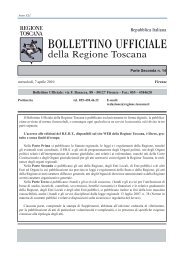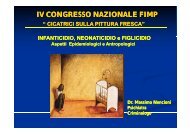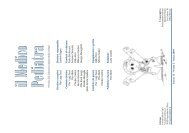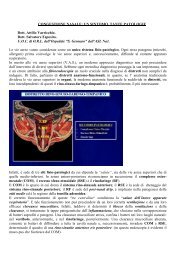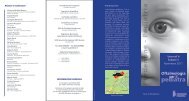Il monitoraggio della permuta dentaria relatore Dott. ERSILIA ... - Fimp
Il monitoraggio della permuta dentaria relatore Dott. ERSILIA ... - Fimp
Il monitoraggio della permuta dentaria relatore Dott. ERSILIA ... - Fimp
You also want an ePaper? Increase the reach of your titles
YUMPU automatically turns print PDFs into web optimized ePapers that Google loves.
SAPIENZA<br />
UNIVERSITA’ DI ROMA<br />
I Facoltà di Medicina e Chirurgia<br />
Scuola di Specializzazione in<br />
Ortognatodonzia<br />
Azienda Policlinico Umberto I<br />
UOC di Ortognatodonzia<br />
Direttore: Prof. Ersilia Barbato<br />
<strong>Il</strong> <strong>monitoraggio</strong> <strong>della</strong> <strong>permuta</strong> <strong>dentaria</strong><br />
Ersilia Barbato
<strong>Il</strong> <strong>monitoraggio</strong> <strong>della</strong> <strong>permuta</strong> dentarie<br />
Dentizione<br />
decidua<br />
Dentizione<br />
mista precoce<br />
Dentizione<br />
mista tardiva<br />
Dentizione<br />
permanente<br />
E.B.
<strong>Il</strong> <strong>monitoraggio</strong> <strong>della</strong> <strong>permuta</strong> dentarie<br />
E.B.
<strong>Il</strong> <strong>monitoraggio</strong> <strong>della</strong> <strong>permuta</strong> dentarie<br />
E.B.
<strong>Il</strong> <strong>monitoraggio</strong> <strong>della</strong> <strong>permuta</strong> dentarie<br />
E.B.
<strong>Il</strong> <strong>monitoraggio</strong> <strong>della</strong> <strong>permuta</strong> dentarie<br />
GUIDELINE ON MANAGEMENT OF THE DEVELOPING DENTITION AND<br />
OCCLUSION IN PEDIATRIC DENTISTRY<br />
American Academy of Pediatric Dentistry (AAPD)<br />
(Reference Manual 2005-2006)<br />
“Le linee guida scaturite dalla convinzione che la loro<br />
conoscenza possa contribuire ad una diagnosi precoce di quelle<br />
condizioni di rischio nella dentizione in via di sviluppo.”<br />
E.B.
<strong>Il</strong> <strong>monitoraggio</strong> <strong>della</strong> <strong>permuta</strong> dentarie<br />
GUIDELINE ON MANAGEMENT OF THE DEVELOPING DENTITION AND<br />
OCCLUSION IN PEDIATRIC DENTISTRY<br />
American Academy of Pediatric Dentistry (AAPD)<br />
(Reference Manual 2005-2006)<br />
“Le linee guida scaturite dalla convinzione che la loro<br />
conoscenza possa contribuire ad una diagnosi precoce di quelle<br />
condizioni di rischio nella dentizione in via di sviluppo.”<br />
Funzionale<br />
Stabile<br />
Esteticamente<br />
Accettabile<br />
E.B.
INDICATORI DI RISCHIO<br />
CORRELATI ALLO SVILUPPO OCCLUSALE ED ALLA PERMUTA<br />
DENTALE<br />
anomalie di numero, posizione, etc.<br />
disturbi localizzati dell’eruzione<br />
gestione dello spazio<br />
AMBIENTALI FUNZIONALI<br />
Valutazione degli equilibri funzionali<br />
SCHELETRICI<br />
trasversali (morsi crociati, asimmetrie !!)<br />
sagittali (Classi I, II, III)<br />
verticali<br />
mantenimento<br />
creazione<br />
recupero<br />
American Academy of Pediatric Dentistry (AAPD) Reference Manual 2005-2006<br />
E.B.
<strong>Il</strong> <strong>monitoraggio</strong> <strong>della</strong> <strong>permuta</strong> dentarie<br />
Ai fini di un fisiologico sviluppo delle arcate risulta<br />
indispensabile un attento <strong>monitoraggio</strong> <strong>della</strong><br />
<strong>permuta</strong> con il controllo di tutti i diversi fattori<br />
che possono influire su un armonico sviluppo<br />
dell’occlusione
<strong>Il</strong> <strong>monitoraggio</strong> <strong>della</strong> <strong>permuta</strong> dentarie<br />
Emergenza:<br />
processo per il quale l’elemento<br />
dentale affiora nel cavo orale<br />
E.B.
<strong>Il</strong> <strong>monitoraggio</strong> <strong>della</strong> <strong>permuta</strong> dentarie<br />
Intraossea<br />
percorso intraosseo che il<br />
dente compie dal punto di<br />
sviluppo <strong>della</strong> sua gemma<br />
fino alla sede<br />
d’emergenza nel cavo<br />
orale<br />
Eruzione<br />
E.B.
<strong>Il</strong> <strong>monitoraggio</strong> <strong>della</strong> <strong>permuta</strong> dentarie<br />
Intraossea<br />
percorso intraosseo che il<br />
dente compie dal punto di<br />
sviluppo <strong>della</strong> sua gemma<br />
fino alla sede<br />
d’emergenza nel cavo<br />
orale<br />
Eruzione<br />
Intraorale<br />
processo per il quale<br />
l’elemento dentale,<br />
emerso nel cavo orale,<br />
raggiunge il piano<br />
occlusale<br />
E.B.
<strong>Il</strong> <strong>monitoraggio</strong> <strong>della</strong> <strong>permuta</strong> dentarie<br />
Intraossea<br />
percorso intraosseo che il<br />
dente compie dal punto di<br />
sviluppo <strong>della</strong> sua gemma<br />
fino alla sede<br />
d’emergenza nel cavo<br />
orale<br />
Eruzione<br />
Intraorale<br />
processo per il quale<br />
l’elemento dentale,<br />
emerso nel cavo orale,<br />
raggiunge il piano<br />
occlusale<br />
E.B.
<strong>Il</strong> <strong>monitoraggio</strong> <strong>della</strong> <strong>permuta</strong> dentarie<br />
Eruzione intraossea<br />
•La localizzazione del germe di un dente<br />
permanente all’inizio <strong>della</strong> sua calcificazione risulta<br />
importante per la sua successiva eruzione,<br />
influendo sulla lunghezza radicolare.<br />
E.B.
<strong>Il</strong> <strong>monitoraggio</strong> <strong>della</strong> <strong>permuta</strong> dentarie<br />
Processo eruttivo intraosseo ha inizio dopo che ¼ <strong>della</strong><br />
radice del permanente si è morfostrutturata. Avrà,<br />
quindi, inizio il riassorbimento radicolare del deciduo<br />
<strong>Il</strong> permanente perfora il tessuto gengivale ed emerge<br />
nel cavo orale quando la sua radice si è<br />
sviluppata per 3/4.<br />
E.B.
<strong>Il</strong> <strong>monitoraggio</strong> <strong>della</strong> <strong>permuta</strong> dentarie<br />
•Fase prenatale<br />
•Fase post-natale<br />
•Dentizione decidua<br />
•1° fase transizionale (Dentizione mista precoce)<br />
•Fase intertransizionale<br />
•2° fase transizionale (Dentizione mista tardiva)<br />
•Dentizione permanente<br />
SVILUPPO DELLA DENTIZIONE<br />
(Van der Linden)<br />
E.B.
<strong>Il</strong> <strong>monitoraggio</strong> <strong>della</strong> <strong>permuta</strong> dentarie<br />
Dentizione<br />
decidua<br />
Dentizione<br />
mista precoce<br />
Dentizione<br />
mista tardiva<br />
Fase maggiormente critica<br />
nello sviluppo <strong>della</strong> dentizione<br />
(Van der Linden)<br />
Dentizione<br />
permanente<br />
E.B.
<strong>Il</strong> <strong>monitoraggio</strong> <strong>della</strong> <strong>permuta</strong> dentarie<br />
•Fase prenatale<br />
Fase post-natale<br />
SVILUPPO DELLA DENTIZIONE
<strong>Il</strong> <strong>monitoraggio</strong> <strong>della</strong> <strong>permuta</strong> dentarie<br />
• Le arcate hanno forma ovoidale<br />
• Sono presenti dei diastemi soprattutto nei settori anteriori<br />
(spazio presente per far erompere i permanenti)<br />
• Elementi dentali sono perpendicolari al piano occlusale<br />
Dentizione decidua<br />
• I molari inferiori occludono più lingualmente rispetto ai superiori e<br />
sono leggermente più mesiali<br />
• L’occlusione a livello dei molari decidui si articola su di un’ampia<br />
superficie
<strong>Il</strong> <strong>monitoraggio</strong> <strong>della</strong> <strong>permuta</strong> dentarie Dentizione decidua<br />
Visione laterale delle basi mascellari – aa. 4<br />
(Van der Linden)
<strong>Il</strong> <strong>monitoraggio</strong> <strong>della</strong> <strong>permuta</strong> dentarie<br />
•Fase prenatale<br />
•Fase post-natale<br />
•Dentizione decidua<br />
•1° fase transizionale (Dentizione mista precoce)<br />
•Fase intertransizionale<br />
•2° fase transizionale (Dentizione mista tardiva)<br />
•Dentizione permanente<br />
SVILUPPO DELLA DENTIZIONE
<strong>Il</strong> <strong>monitoraggio</strong> <strong>della</strong> <strong>permuta</strong> dentarie<br />
1° FASE TRANSIZIONALE<br />
(dentizione mista precoce)<br />
• Eruzione dei primi molari permanenti<br />
• Permuta degli incisivi centrali e laterali superiori ed<br />
inferiori (denti permanenti hanno dimensioni maggiori ai<br />
corrispondenti decidui !!)
<strong>Il</strong> <strong>monitoraggio</strong> <strong>della</strong> <strong>permuta</strong> dentarie<br />
1° FASE TRANSIZIONALE<br />
(dentizione mista precoce)<br />
PROCESSO DI PERMUTA<br />
• ESFOLIAZIONE DEL DECIDUO<br />
• ERUZIONE DEL PERMANENTE<br />
Dura circa 3 anni, dalla prima modifica che incorre nell’arcata<br />
decidua all’eruzione completa di tutti gli incisivi permanenti
<strong>Il</strong> <strong>monitoraggio</strong> <strong>della</strong> <strong>permuta</strong> dentarie<br />
1° FASE TRANSIZIONALE<br />
(dentizione mista precoce)<br />
PROCESSO DI PERMUTA
<strong>Il</strong> <strong>monitoraggio</strong> <strong>della</strong> <strong>permuta</strong> dentarie<br />
1° FASE TRANSIZIONALE<br />
(dentizione mista precoce)<br />
SETTORE POSTERIORE<br />
• I premolari sono localizzati tra le radici dei<br />
molari decidui e inferiormente a questi.<br />
• Le dimensioni dei premolari < molari decidui<br />
Visione laterale delle basi mascellari – aa. 6<br />
(Van der Linden)
<strong>Il</strong> <strong>monitoraggio</strong> <strong>della</strong> <strong>permuta</strong> dentarie<br />
E.B.
<strong>Il</strong> <strong>monitoraggio</strong> <strong>della</strong> <strong>permuta</strong> dentarie<br />
E.B.
<strong>Il</strong> <strong>monitoraggio</strong> <strong>della</strong> <strong>permuta</strong> dentarie<br />
E.B.
<strong>Il</strong> <strong>monitoraggio</strong> <strong>della</strong> <strong>permuta</strong> dentarie<br />
E.B.
<strong>Il</strong> <strong>monitoraggio</strong> <strong>della</strong> <strong>permuta</strong> dentarie<br />
E.B.
<strong>Il</strong> <strong>monitoraggio</strong> <strong>della</strong> <strong>permuta</strong> dentarie<br />
E.B.
<strong>Il</strong> <strong>monitoraggio</strong> <strong>della</strong> <strong>permuta</strong> dentarie<br />
E.B.
E.B.
<strong>Il</strong> <strong>monitoraggio</strong> <strong>della</strong> <strong>permuta</strong> dentarie<br />
•Fase prenatale<br />
•Fase post-natale<br />
•Dentizione decidua<br />
•1° fase transizionale (Dentizione mista precoce)<br />
•Fase intertransizionale<br />
•2° fase transizionale (Dentizione mista tardiva)<br />
•Dentizione permanente<br />
SVILUPPO DELLA DENTIZIONE
<strong>Il</strong> <strong>monitoraggio</strong> <strong>della</strong> <strong>permuta</strong> dentarie<br />
FASE INTERTRANSIZIONALE<br />
La maggior parte delle modifiche non sono<br />
clinicamente evidenti<br />
ORTOPANTOMOGRAFIA
<strong>Il</strong> <strong>monitoraggio</strong> <strong>della</strong> <strong>permuta</strong> dentarie<br />
Visione delle basi mascellari – aa. 8<br />
(Van der Linden)<br />
E.B.
<strong>Il</strong> <strong>monitoraggio</strong> <strong>della</strong> <strong>permuta</strong> dentarie<br />
• Nell’arcata superiore la convergenza delle radici degli incisivi<br />
corrisponde ad una disto-inclinazione coronale con la comparsa di<br />
diastemi interincisivi (ugly duck).<br />
Visione laterale delle basi mascellari – aa. 9<br />
(Van der Linden)<br />
E.B.
<strong>Il</strong> <strong>monitoraggio</strong> <strong>della</strong> <strong>permuta</strong> dentarie<br />
•Fase prenatale<br />
•Fase post-natale<br />
•Dentizione decidua<br />
•1° fase transizionale (Dentizione mista precoce)<br />
•Fase intertransizionale<br />
•2° fase transizionale (Dentizione mista tardiva)<br />
•Dentizione permanente<br />
SVILUPPO DELLA DENTIZIONE<br />
E.B.
<strong>Il</strong> <strong>monitoraggio</strong> <strong>della</strong> <strong>permuta</strong> dentarie<br />
Visione delle basi mascellari – aa. 10<br />
(Van der Linden)
<strong>Il</strong> <strong>monitoraggio</strong> <strong>della</strong> <strong>permuta</strong> dentarie<br />
2° FASE TRANSIZIONALE<br />
(dentizione mista precoce)<br />
• Eruzione dei secondi molari permanenti<br />
• Permuta dei canini superiori ed inferiori (i permanenti hanno<br />
dimensioni inferiori rispetto ai corrispondenti decidui !!)<br />
• Permuta dei primi e secondi molari decidui con i premolari (i<br />
denti permanenti hanno dimensioni inferiori rispetto ai<br />
corrispondenti decidui !!)
<strong>Il</strong> <strong>monitoraggio</strong> <strong>della</strong> <strong>permuta</strong> dentarie<br />
2° FASE TRANSIZIONALE<br />
(dentizione mista precoce)<br />
La diametro mesio-distale dei molari decidui è maggiore del<br />
diametro mesio-distale dei premolari<br />
(soprattutto i secondi premolari!!).<br />
lee-way space = spazio che residua dalla <strong>permuta</strong> dei molari<br />
decidui con i premolari
<strong>Il</strong> <strong>monitoraggio</strong> <strong>della</strong> <strong>permuta</strong> dentarie<br />
E.B.
<strong>Il</strong> <strong>monitoraggio</strong> <strong>della</strong> <strong>permuta</strong> dentarie<br />
E.B.
<strong>Il</strong> <strong>monitoraggio</strong> <strong>della</strong> <strong>permuta</strong> dentarie<br />
E.B.
<strong>Il</strong> <strong>monitoraggio</strong> <strong>della</strong> <strong>permuta</strong> dentarie<br />
E.B.
<strong>Il</strong> <strong>monitoraggio</strong> <strong>della</strong> <strong>permuta</strong> dentarie<br />
E.B.
<strong>Il</strong> <strong>monitoraggio</strong> <strong>della</strong> <strong>permuta</strong> dentarie<br />
E.B.
<strong>Il</strong> <strong>monitoraggio</strong> <strong>della</strong> <strong>permuta</strong> dentarie<br />
E.B.
<strong>Il</strong> <strong>monitoraggio</strong> <strong>della</strong> <strong>permuta</strong> dentarie<br />
Correzione discrepanza<br />
scheletrica<br />
Monitoraggio<br />
<strong>permuta</strong> dentale<br />
E.B.
<strong>Il</strong> <strong>monitoraggio</strong> <strong>della</strong> <strong>permuta</strong> dentarie<br />
E.B.
<strong>Il</strong> <strong>monitoraggio</strong> <strong>della</strong> <strong>permuta</strong> dentarie<br />
E.B.
<strong>Il</strong> <strong>monitoraggio</strong> <strong>della</strong> <strong>permuta</strong> dentarie<br />
E.B.
<strong>Il</strong> <strong>monitoraggio</strong> <strong>della</strong> <strong>permuta</strong> dentarie<br />
E.B.
<strong>Il</strong> <strong>monitoraggio</strong> <strong>della</strong> <strong>permuta</strong> dentarie<br />
E.B.
<strong>Il</strong> <strong>monitoraggio</strong> <strong>della</strong> <strong>permuta</strong> dentarie<br />
E.B.
<strong>Il</strong> <strong>monitoraggio</strong> <strong>della</strong> <strong>permuta</strong> dentarie<br />
E.B.
<strong>Il</strong> <strong>monitoraggio</strong> <strong>della</strong> <strong>permuta</strong> dentarie<br />
Ortopantomografia<br />
Rx endorali<br />
DIAGNOSI RADIOGRAFICA<br />
Rx occlusale<br />
Teleradiografia latero- laterale<br />
Teleradiografia frontale<br />
CT-DENTASCAN<br />
E.B.
VALUTAZIONI RADIOGRAFICHE<br />
<strong>Il</strong> fallimento delle procedure radiografiche<br />
convenzionali risiede nell’impossibilità di individuare i<br />
reciproci rapporti tra canino e denti contigui, in<br />
particolare con l’incisivo laterale<br />
E.B.
VALUTAZIONI RADIOGRAFICHE<br />
E.B.
<strong>Il</strong> <strong>monitoraggio</strong> <strong>della</strong> <strong>permuta</strong> dentarie<br />
E.B.
E.B.
E.B.
<strong>Il</strong> <strong>monitoraggio</strong> <strong>della</strong> <strong>permuta</strong> dentarie<br />
E.B.
<strong>Il</strong> <strong>monitoraggio</strong> <strong>della</strong> <strong>permuta</strong> dentarie<br />
Estrazione del<br />
canino deciduo !<br />
E.B.
E.B.
<strong>Il</strong> <strong>monitoraggio</strong> <strong>della</strong> <strong>permuta</strong> dentarie<br />
E.B.
<strong>Il</strong> <strong>monitoraggio</strong> <strong>della</strong> <strong>permuta</strong> dentarie<br />
•Fase prenatale<br />
•Fase post-natale<br />
•Dentizione decidua<br />
•1° fase transizionale (Dentizione mista precoce)<br />
•Fase intertransizionale<br />
•2° fase transizionale (Dentizione mista tardiva)<br />
•Dentizione permanente<br />
SVILUPPO DELLA DENTIZIONE<br />
E.B.
<strong>Il</strong> <strong>monitoraggio</strong> <strong>della</strong> <strong>permuta</strong> dentarie<br />
•Fase prenatale<br />
Funzionale<br />
•Fase post-natale<br />
•Dentizione decidua<br />
•1° fase transizionale (Dentizione mista precoce)<br />
•Fase intertransizionale<br />
•2° fase transizionale (Dentizione mista tardiva)<br />
•Dentizione permanente<br />
SVILUPPO DELLA DENTIZIONE<br />
Stabile<br />
Esteticamente<br />
Accettabile<br />
E.B.
E.B.
<strong>Il</strong> <strong>monitoraggio</strong> <strong>della</strong> <strong>permuta</strong> dentarie<br />
CONSIDERAZIONI CONCLUSIVE<br />
L’eruzione di ciascun dente – per i vari gruppi di denti - è prevista<br />
ad una determinata età; tuttavia, essa può essere influenzata da<br />
fattori locali e generali, in grado di favorire un’eruzione precoce o<br />
tardiva, spesso notevolmente differente rispetto al<br />
normale timing eruttivo.<br />
……L’epoca prevista d’eruzione non rappresenta, quindi, un metodo<br />
affidabile per stabilire l’età dentale.<br />
(A. Becker 1998)<br />
E.B.
<strong>Il</strong> <strong>monitoraggio</strong> <strong>della</strong> <strong>permuta</strong> dentarie<br />
CONSIDERAZIONI CONCLUSIVE<br />
<strong>Il</strong> processo eruttivo, sia esso intraosseo che intraorale,<br />
rappresenta un fenomeno complesso, al quale concorrono<br />
contemporaneamente molteplici fattori e che può essere alterato<br />
da fattori genetici, molecolari, cellulari o tissutali.<br />
(E. Barberia-Leache, M. Cruz Suarez-Clua, D. Saavedra-Ontiveros,<br />
Angle Orthod. 2005)<br />
E.B.
<strong>Il</strong> <strong>monitoraggio</strong> <strong>della</strong> <strong>permuta</strong> dentarie<br />
CONSIDERAZIONI CONCLUSIVE<br />
Tra i disordini correlati all’eruzione dentale, molti si verificano<br />
durante lo stadio di dentizione mista. La precoce individuazione<br />
di possibili indicatori di rischio ed un intervento tempestivo, di<br />
tipo preventivo e/o intercettivo, consentono di utilizzare le forze<br />
d’eruzione fisiologiche con la possibilità di prevenire quadri<br />
occlusali più complessi.<br />
(E. Barberia-Leache, M. Cruz Suarez-Clua, D. Saavedra-Ontiveros,<br />
Angle Orthod. 2005)<br />
E.B.
<strong>Il</strong> <strong>monitoraggio</strong> <strong>della</strong> <strong>permuta</strong> dentarie<br />
ESAME CLINICO<br />
CHECK-UP DELLA PERMUTA<br />
FOLLOW-UP<br />
ESAME<br />
ORTOPANTOMOGRAFICO<br />
7 12 anni<br />
E.B.
E.B.





